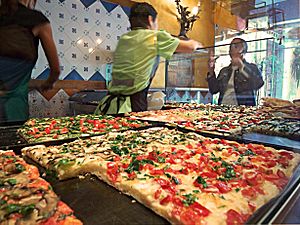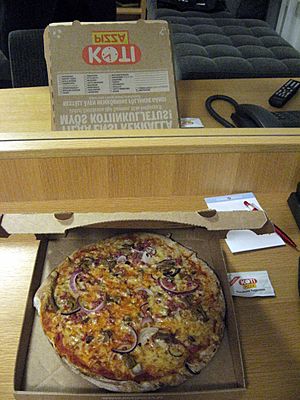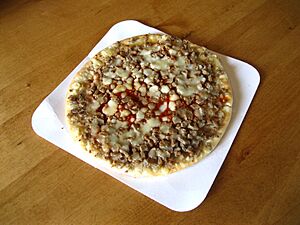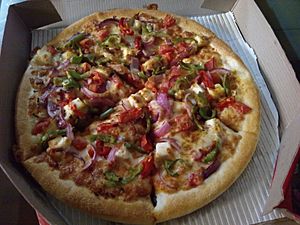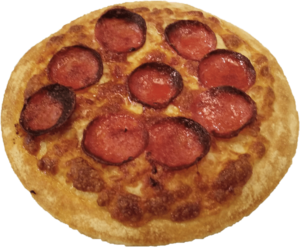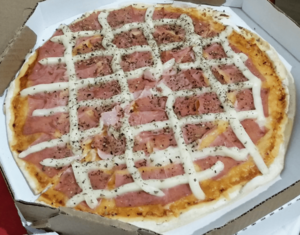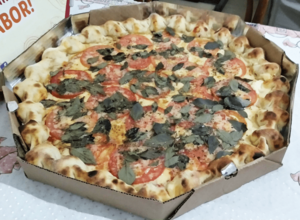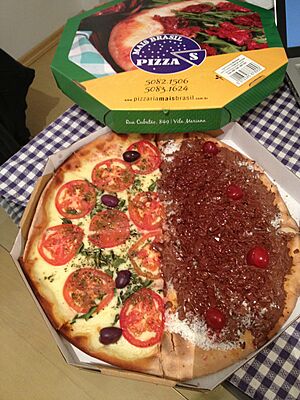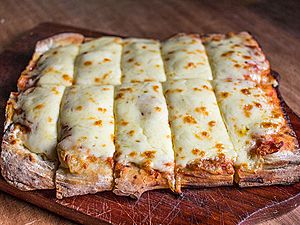List of pizza varieties by country facts for kids
Pizza is a super popular dish from Italy that people all over the world love! It's so famous that it started spreading to other countries in the early 1900s, and now you can find it almost everywhere.
Contents
Pizza Around the World
Pizza might have started in Italy, but it has traveled the globe! Many countries have put their own special spin on it, using local ingredients and flavors. Let's explore some of these amazing pizza varieties!
Europe
Italy: Where Pizza Began
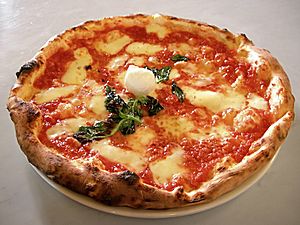
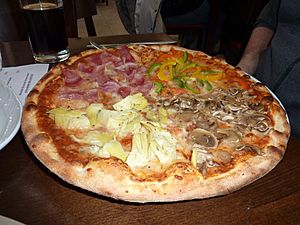
The most famous Italian pizza is probably the Neapolitan pizza (pizza napoletana). It comes from the city of Naples. Real Neapolitan pizzas are usually made with fresh tomatoes and mozzarella cheese. Some special ingredients include San Marzano tomatoes, which grow near the volcano Mount Vesuvius, and mozzarella di bufala Campana, made from the milk of water buffalo. This special mozzarella even has a protected status in Europe!
To make a true Neapolitan pizza, the dough is made with special flour, yeast, salt, and water. It's kneaded by hand or with a slow mixer. After the dough rises, it's shaped by hand (no rolling pins!) to be super thin, about 3 millimeters (0.12 inches) thick. Then, it's baked for just 60-90 seconds in a super hot stone oven (around 485°C or 905°F) heated by oak wood. When it's done, it should be crispy, tender, and smell amazing!
There are three official kinds of Neapolitan pizza:
- Pizza marinara: Made with tomato, garlic, oregano, and olive oil.
- Pizza Margherita: Made with tomato, sliced mozzarella, basil, and olive oil.
- Pizza Margherita di bufala: Similar to Margherita, but with buffalo mozzarella.
This special Neapolitan pizza is even protected in Europe as a "Traditional Speciality Guaranteed" product.
In Rome, you'll find two main styles of pizza. Take-away shops sell pizza al taglio (pizza by the slice). This pizza is cooked in long, rectangular pans and is quite thick, about 1-2 centimeters (0.4-0.8 inches). It's often cooked in an electric oven and sold by weight. In sit-down pizzerias, pizza is round and has a thin, crispy base, very different from the softer Neapolitan style. It's usually cooked in a wood-fired oven for a special flavor.
Other cool Italian pizzas include:
- Pizza capricciosa: Has mozzarella, tomato, mushrooms, artichokes, cooked ham, and olives.
- Pizza quattro formaggi: Means "four cheese pizza." It usually has tomatoes and four different cheeses like mozzarella, stracchino, fontina, and gorgonzola.
- Pizza bianca: This is a "white pizza" that doesn't have tomato sauce. It's like a bread topped with olive oil, salt, and sometimes herbs like rosemary.
- Pizzetta: A small pizza, often served as a snack.
- Sicilian pizza: From Sicily, this pizza is often thick-crusted. In Sicily, it's called Sfincione.
- Pizza diavola: A spicy pizza made with spicy sausage, tomato sauce, and cheese.
Hungary: Spicy and Savory Pizzas
In Hungary, people love traditional pizza toppings, but they also have unique local kinds. The "Magyaros" (Hungarian-style) pizza often has toppings like bacon, Hungarian sausage (kolbász), salami, hot peppers, and red onion. "White pizza" (without tomato sauce) is also popular because it's similar to a Hungarian flatbread called kenyérlángos.
Finland: Reindeer Pizza!
Finland has a unique pizza called "Poro," which means reindeer. It used to be called "Berlusconi" pizza! It has smoked reindeer meat, tomato sauce, cheese, chanterelle mushrooms, and red onion. Frozen pizzas are also a huge deal in Finland, with millions sold every year.
Iceland: Bananas on Pizza?
Iceland has many traditional pizza toppings, but one common and unique topping you might find there is bananas!
Norway: Pizza Lovers of the World
People in Norway eat more pizza than anyone else in the world! In 2004, they ate about 5.4 kilograms (12 pounds) of pizza per person each year. A frozen pizza brand called Grandiosa is super popular there. It's so loved that it's sometimes called "The national dish of Norway"!
Sweden: Kebab Pizza and More
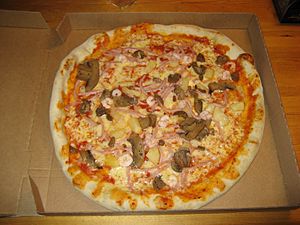

The first pizza in Sweden was served in 1947. Swedish pizzas are usually thicker than Neapolitan ones, with more spiced sauce, and not as crispy. They often use Swedish hard cheese instead of mozzarella. One of the most popular pizzas in Sweden since the 1980s is kebab pizza! There's even a super extreme pizza called "Calskrove" which is a calzone (folded pizza) with a whole hamburger and fries baked inside!
United Kingdom and Ireland: Deep-Fried Pizza!
Since the 1980s, you can find all kinds of pizzas in the United Kingdom and Ireland, from Italian style to American style, and even homemade ones. People sometimes use local ingredients like bacon instead of prosciutto, and cheddar cheese instead of mozzarella. You'll find big pizza chains like PizzaExpress and Domino's, as well as small local restaurants.
Some popular toppings include "Hawaiian" (ham and pineapple), "Pepperoni," and "Meat Feast." Sweetcorn is a common topping in the UK, which is pretty unique compared to other countries. In some parts of Scotland, you can even find a "pizza crunch" – a frozen pizza that's dipped in batter and deep-fried!
Asia
China: Local Flavors
Pizza has become very popular in China. Pizza Hut opened its first restaurant there in 1990. To fit local tastes, Pizza Hut changed its recipes to include Chinese ingredients like crab sticks, tuna, soy sauce, and corn.
India: Spicier Pizzas
Pizza is a growing fast food in India. India is the biggest market for Domino's Pizza outside the US! Indian pizzas are usually spicier and have more vegetables than pizzas in other countries. You might get oregano spice packs with your pizza instead of Parmesan cheese. Unique toppings include pickled ginger, tandoori chicken, and paneer (a type of cheese).
Indonesia: Fusion Pizzas
In Indonesia, Pizza Hut is the biggest pizza chain. Besides regular pizzas, you can find amazing Indonesian "fusion" pizzas that use local favorites as toppings. Imagine pizzas with spicy balado chili pepper, savory beef rendang, or even satay with peanut sauce! Other Asian fusion pizzas like Tom Yum (from Thailand) or Bulgogi (from South Korea) are also popular.
Japan: Squid and Mochi Crusts
American pizza chains came to Japan in the 1970s. Japanese pizzas often use mayonnaise sauces and sometimes unusual ingredients like corn, potatoes, avocado, eel, or even honey or chocolate (for dessert pizzas!). One unique topping you might find in Japan is squid. You can also find "mochi pizza," where the crust is made from Japanese mochi cakes.
Korea: Sweet Potato and Shrimp
Pizza is a popular snack in South Korea, especially for young people. Besides big American brands, there are Korean brands like Mr. Pizza. Korean-style pizza can be quite fancy, with toppings like corn, potato wedges, sweet potato, shrimp, or crab. North Korea even opened its first pizzeria in its capital, Pyongyang, in 2009!
Pakistan: Chicken Tikka Pizza
Pizza became popular in Pakistan in the late 1980s. In the eastern parts of Pakistan, spicy chicken and sausage-based pizzas are very popular because they suit the local taste. Chicken Tikka and achari chicken pizzas are favorites!
Philippines: Thin, Sweet, and Local Toppings
Pizza arrived in the Philippines when Americans were there. Filipino-style pizza is often thinner and sweeter, similar to Hawaiian pizza. You can also find unique versions with traditional Filipino dishes like sardines, dried fish (tinapa), crispy pork belly (bagnet), and sausages (longganisa) as toppings.
Thailand: Durian Pizza
The Pizza Company in Thailand introduced durian pizza in 2018. Durian is a fruit known for its strong smell! Thai-style pizzas can also have peanut-based sauces and ingredients like tofu, bean sprouts, and cilantro.
Israel: Kosher Pizza
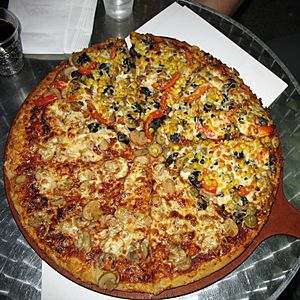
Many pizza places in Israel are kosher. This means they follow Jewish dietary rules, so they either don't have meat or use fake meat, because you can't mix meat and dairy (like cheese). Kosher pizza places also close during the holiday of Passover, when leavened bread isn't allowed. Some Israeli pizzas have lots of vegetable toppings like mushrooms or onions, and sometimes even corn!
Turkey: Local Meats and Cheeses
Pizza places in Turkey offer a mix of international and local styles. While many toppings are similar to Italy, you'll find special Turkish ingredients like minced beef, spicy sausage (Sucuk), cured meats (Pastırma), and local cheeses like Kaşar. Pork products are usually not available, so they use beef, chicken, or lamb instead. Turkey also has traditional dishes similar to pizza, like Black Sea–style Pide.
North America
Canada: Garlic Fingers

Canada has its own pizza chains and many unique regional pizzas. For example, in Nova Scotia, you might find "garlic fingers," which are like a pizza crust with garlic butter and cheese, often served with donair sauce for dipping!
Mexico: Chorizo and Jalapeños
Pizza in Mexico uses ingredients typical of Mexican cuisine. Common toppings include chorizo (a type of sausage), jalapeño pepper slices, grilled onions, and avocado. Sometimes they use pepper jack cheese or Oaxaca cheese instead of mozzarella.
United States: Many Styles!


The first pizza place in the United States opened in New York City in 1905. Because so many Italian immigrants came to the U.S., different regions developed their own pizza styles.
- Chicago has its famous deep-dish pizza, which is very thick.
- New York–style pizza is known for its thin crust and is popular in New York, New Jersey, and Connecticut.
- New Haven–style pizza in Connecticut is cooked in super hot coal-fired ovens.
- In the Midwest, you'll find "tavern style" pizzas with thin crusts cut into rectangles.
- Philadelphia pizzas often have the sauce on top of the cheese.
- Detroit-style pizza is a square pizza with a thick, crispy deep-dish crust, and the sauce is usually on top of the cheese. Its square shape comes from using metal trays that were originally for factory parts!
- The "jumbo slice" in Washington, D.C., is an extra-large slice of New York–style pizza.
- The "white clam pie" started in New Haven, Connecticut.
- Barbecue pizza, with pulled pork and barbecue sauce, became popular in the Southern United States. In California, barbecue chicken pizza is a favorite.
Oceania
Australia: The "Aussie" Pizza
In Australia, you can find Italian and American style pizzas. A unique type is the "Aussie" or "Australiana" pizza. It usually has a tomato base, mozzarella cheese, and toppings like chicken, ham, bacon, and egg (like a classic Australian breakfast!). Pizzas with seafood like prawns are also popular. Some "gourmet pizzas" might even have unusual toppings like kangaroo meat, emu, or crocodile!
New Zealand: Spaghetti Pizza!
New Zealand has many independent pizza restaurants and chains. One famous local chain is Hell Pizza, known for its interesting marketing and using free-range ingredients. New Zealanders love to try new things with pizza toppings!
In 2017, "spaghetti pizza" got a lot of attention when the Prime Minister, Bill English, shared a recipe for it on Facebook. It included tinned spaghetti and even pineapple! In 2019, Domino's Pizza in New Zealand even added a "Hawaiian Spaghetti Pizza" to its menu.
South America
Brazil: Sweet and Savory Pizzas
São Paulo, Brazil, is one of the biggest pizza-loving cities in the world, right after New York City! Brazilians eat millions of pizzas every day. The first Brazilian pizzas were made in the late 1800s.
Brazilian pizzas often have less tomato sauce than Italian ones. A common ingredient is requeijão, a creamy white cheese. You'll often see pepperoni or ham pizzas with requeijão on top. Brazil's "four cheese" pizza (quatro queijos) usually has mozzarella, requeijão, Parmesan, and provolone.
Calabresa pizza (with a Brazilian sausage) is super popular. Shredded chicken with requeijão is also a favorite. Brazilians are very creative with toppings! You might find pizzas with chicken or beef Stroganoff, cheeseburgers, French fries, or even fettuccine!
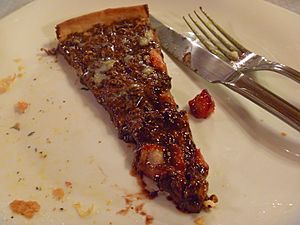
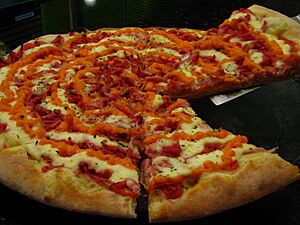
Sweet pizzas are also very common in Brazil! They usually come in two main types: chocolate or banana. Chocolate pizzas can have sprinkles, M&M's, strawberries, or even ice cream. Banana pizzas are usually covered in sugar and cinnamon. You can even get sweet pizzas with stuffed crusts filled with chocolate or Nutella!
Colombia: Hawaiian Pizza Lovers
"Hawaiian pizza" (with ham and pineapple) is very popular in Colombia.
Uruguay: Rectangular Pizzas
Pizza is a big part of the food culture in Uruguay, which has a lot of people with Italian backgrounds. Typical Uruguayan pizzas are medium-thick and rectangular. They are often cooked in a clay oven, which is why they are called "a la piedra" (on the stone).
Common toppings include ham, olives, peppers, mushrooms, and mussels. You might also find pizza rellena (stuffed pizza) or pizza a la parrilla (grilled pizza). A special kind of pizza called figazza is like a thick pizza dough topped with onions, and sometimes olives or bell peppers. Pizza slices are often served with fainá, a flatbread made from chickpea flour.
Images for kids
-
Pizzas with rucola in Chernihiv, 2018
-
Pizza quattro formaggi with nuts at restaurant in Chernihiv, 2021
-
Pizza with salami and mozzarella stuffed crust at restaurant in Ivano-Frankivsk, October 2021
See also
- List of pizza chains


